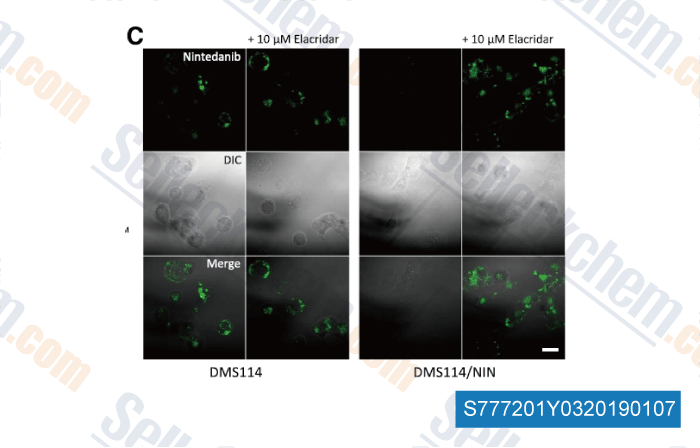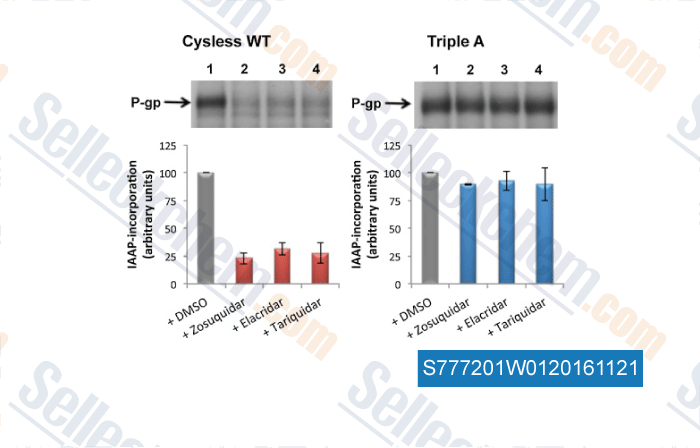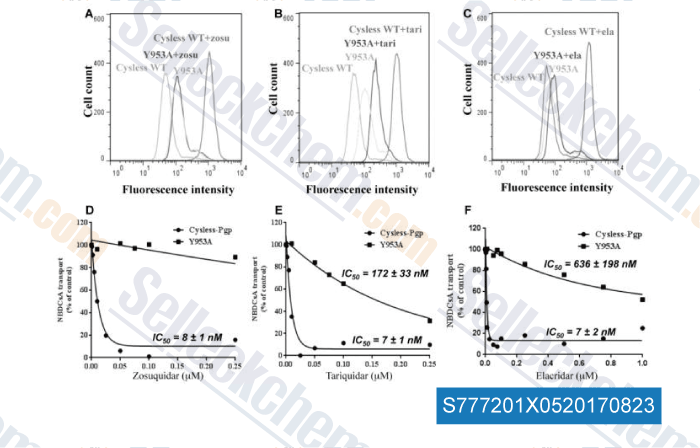|
Toll Free: (877) 796-6397 -- USA and Canada only -- |
Fax: +1-832-582-8590 Orders: +1-832-582-8158 |
Tech Support: +1-832-582-8158 Ext:3 Please provide your Order Number in the email. |
Technical Data
| Formula | C34H33N3O5 |
||||||
| Molecular Weight | 563.64 | CAS No. | 143664-11-3 | ||||
| Solubility (25°C)* | In vitro | DMSO | 100 mg/mL (177.41 mM) | ||||
| Water | Insoluble | ||||||
| Ethanol | Insoluble | ||||||
| In vivo (Add solvents to the product individually and in order) |
|
||||||
|
* <1 mg/ml means slightly soluble or insoluble. * Please note that Selleck tests the solubility of all compounds in-house, and the actual solubility may differ slightly from published values. This is normal and is due to slight batch-to-batch variations. * Room temperature shipping (Stability testing shows this product can be shipped without any cooling measures.) |
|||||||
Preparing Stock Solutions
Biological Activity
| Description | Elacridar (GF120918, GW120918, GG918, GW0918) is a potent P-gp (MDR-1) and BCRP inhibitor. | ||
|---|---|---|---|
| Targets |
|
||
| In vitro | Elacridar inhibits P-glycoprotein (P-gp) labeling by [3H]azidopine with a IC50 of 0.16 μM. [2] In Caki-1 and ACHN cells, elacridar ( 2.5 μM) significantly ihibits the cell growth. The P-glycoprotein activity is found to be inhibited by elacridar. The elacridar in combination lead to a significant reduction in ABC Sub-family B Member 2 (ABCG2) expression in 786-O cells. [3] |
||
| In vivo | Oral co-administration of elacridar (100 mg/kg, p.o.) increases the plasma and brain concentrations and brain-to-plasma ratios in wild-type mice, equaling the levels in Abcb1a/1b; Abcg2-/- mice. [1] In friend leukemia virus stain B mice, the brain-to-plasm partition coefficient (Kp, brain) of elacridar is 0.82, 0.43, and 4.31 after intravenous (2.5 mg/kg), intraperitoneal (100 mg/kg), and oral (100 mg/kg) treatment, respectively. [4] In Mrp4(-/-) mice, elacridar fully inhibits P-gp mediated transport, without siginificant effects on Bcrp1-mediated transport. [5] |
Protocol (from reference)
| Kinase Assay: |
|
|---|---|
| Cell Assay: |
|
| Animal Study: |
|
References
|
Customer Product Validation

-
Data from [ , , J Exp Clin Cancer Res, 2017, 36(1):122 ]

-
Data from [ , , Biochem Pharmacol, 2016, 101:40-53. ]

-
Data from [ , , Biochem Pharmacol, 2016, 101:40-53 ]
Selleck's Elacridar (GF120918) Has Been Cited by 29 Publications
| Screening a living biobank identifies cabazitaxel as a strategy to combat acquired taxol resistance in high-grade serous ovarian cancer [ Cell Rep Med, 2025, 6(6):102160] | PubMed: 40466638 |
| Synthesis of carbon dots from spent coffee grounds: transforming waste into potential biomedical tools [ Nanoscale, 2025, 17(16):9947-9962] | PubMed: 40067158 |
| Targeting SUMOylation in ovarian cancer: Sensitivity, resistance, and the role of MYC [ iScience, 2025, 28(6):112555] | PubMed: 40487451 |
| Elacridar Inhibits BCRP Protein Activity in 2D and 3D Cell Culture Models of Ovarian Cancer and Re-Sensitizes Cells to Cytotoxic Drugs [ Int J Mol Sci, 2025, 26(12)5800] | PubMed: 40565261 |
| The Role of Elacridar, a P-gp Inhibitor, in the Re-Sensitization of PAC-Resistant Ovarian Cancer Cell Lines to Cytotoxic Drugs in 2D and 3D Cell Culture Models [ Int J Mol Sci, 2025, 26(3)1124] | PubMed: 39940891 |
| Overcoming ABCB1 mediated multidrug resistance in castration resistant prostate cancer [ Cell Death Dis, 2024, 15(8):558] | PubMed: 39090086 |
| Targeting the glutamine metabolism to suppress cell proliferation in mesenchymal docetaxel-resistant prostate cancer [ Oncogene, 2024, 43(26):2038-2050] | PubMed: 38750263 |
| Abcg2a is the functional homolog of human ABCG2 expressed at the zebrafish blood-brain barrier [ Fluids Barriers CNS, 2024, 21(1):27] | PubMed: 38491505 |
| Enhanced anticancer effect of thymidylate synthase dimer disrupters by promoting intracellular accumulation [ Front Pharmacol, 2024, 15:1477318] | PubMed: 39611169 |
| Leveraging the Aggregated Protein Dye YAT2150 for Malaria Chemotherapy [ Pharmaceutics, 2024, 16(10)1290] | PubMed: 39458619 |
RETURN POLICY
Selleck Chemical’s Unconditional Return Policy ensures a smooth online shopping experience for our customers. If you are in any way unsatisfied with your purchase, you may return any item(s) within 7 days of receiving it. In the event of product quality issues, either protocol related or product related problems, you may return any item(s) within 365 days from the original purchase date. Please follow the instructions below when returning products.
SHIPPING AND STORAGE
Selleck products are transported at room temperature. If you receive the product at room temperature, please rest assured, the Selleck Quality Inspection Department has conducted experiments to verify that the normal temperature placement of one month will not affect the biological activity of powder products. After collecting, please store the product according to the requirements described in the datasheet. Most Selleck products are stable under the recommended conditions.
NOT FOR HUMAN, VETERINARY DIAGNOSTIC OR THERAPEUTIC USE.
